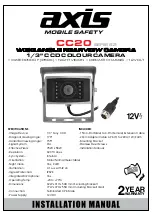
Installation
WARNING!
Only trained electrical installers or competent persons
should install this product. Incorrect installation could lead
to personal injury or death and/or damage to property.
Ensure the electrical regulations specific to your region are
observed, and observed wiring colour conventions.
Ensure the cameras power supply is connected via a
suitably rated fuse or circuit breaker.
Switch off the power supply you are working on whilst
installing the camera, until the product is correctly installed.
Step 1:
Decide the mounting position of your camera and use a
small drill to make a pilot hole where the center of your
camera will be installed.
TIP!
Power up camera and check to ensure you have the
desired field of view prior to drilling any holes and mounting
the camera in place.
Step 2:
Use a 62mm hole saw to drill the hole necessary to fit the
camera body. Prior to drilling, ensure it is safe to do so and
there are no cable runs behind the panel.
Step 3:
Offer the camera up into the hole you have just made,
ensuring that you will be able to sufficiently adjust the
camera module position prior to screwing the housing into
place. The camera module within the housing has limited
‘Pan’ axis adjustment so ensure you can manipulate the
camera to the desired position before proceeding. Twist
the camera as desired then mark off the fixing holes ready
for drilling your pilot holes.
TIP!
Use a CCTV tester if available (or connect to your plotter or
a test laptop) to ensure the correct field of view is achieved
before screwing the camera housing into place.
Step 4:
Present your cables to the camera through the hole you’ve
just drilled. The camera operates at 12VDC and draws
extremely low current. We recommend you use an 18AWG
pair for +DC and DC GND. For the video signal, use a 75
Ω
coaxial cable such as RG59, URM70, RG6. For marine
applications we recommend the conductor is stranded.
Use waterproof tape /self amalgamating tape to protect
the video and power termination and ensure moisture does
not penetrate the connections.
Iris offer a range of power, video and combined power/
video cables. When combining with Balun adapters, you
can also use a single CAT5e/CAT6 cable for power and
data. Contact your Iris dealer for more information.
WARNING!
Ensure the camera power is connected via a suitably
rated fuse or breaker to avoid damage to the vessel
or personal injury.
Step 5:
Slide the ‘slack’ cable from the camera back through the
hole in your panel, ensuring connectors are still in tact and
sit the inner dome onto the protective foam / rubber ring
on the base.
Step 8:
Offer the camera up into the hole you have made, line up
the fixing holes with your screw pilot holes (if you’ve made
them) and screw firmly into place.
Step 9:
Adjust the pan and tilt position of the camera module as
desired. Once the camera is pointing in the correct
position, lock the camera module adjustment screws into
place to prevent the camera module moving under
vibration. Power up the camera and test to ensure you are
happy with the final position. Leave the camera running for
30 minutes without the dome cover and then finally
carefully screw the bezel cover into place, taking care to
avoid cross-threading.
v1.00/17-01-18
Iris Innovations
Unit 15 Fareham Innovation Center, Meteor Way, Lee on Solent. Hampshire PO13 9FU
T


























